Delphi Complete Works of Sir Arthur Conan Doyle (Illustrated) (1229 page)
Read Delphi Complete Works of Sir Arthur Conan Doyle (Illustrated) Online
Authors: SIR ARTHUR CONAN DOYLE

The writing in all these effusions is fluent and easy, with every mark of an educated hand. I can find no evidence that any particular care has been taken to disguise it, but it is naturally unformed, and does not set rigidly into definite characteristics.
From 1896 onwards this individual disappears entirely, and I was at some loss to form an opinion as to whether the mania was real or simulated. It bore every aspect of being real, but on the other hand it was difficult to conceive that such a person could so conceal his mental eccentricity as to escape general comment Some weeks ago, however, an incident occurred which convinced me that the man still lives, and that he is now a marked religious maniac. A newspaper containing some account of the Edalji affair had found its way to Long Beach, California, in the United States. A page of it was sent back to Mr. George Edalji, with religious and blasphemous comments scribbled in pencil all round the margins. The general character of this script the knowledge shown of the case, and the singular mental conditions, have all convinced me that whatever be his name, God-Satan is now to be found on the Pacific Coast and that he is an undoubted madman.
So much for the elder of the three hypothetical individuals, he now drops out of the narrative, and we come to the second. This man writes a closer, smaller hand, with many of his senior’s peculiarities. There is no fancy and no madness in his productions. On the contrary, they are particularly practical. They are usually postcards of an allusive character, sent to someone at a distance, and signed with a forged name. At his ingenious bidding deluded tradesmen have brought huge consignments of goods to the vicarage, brother clergymen have hastened to Wyrley upon all sorts of urgent summonses, and editors have inserted the most monstrous advertisements as to the extraordinary needs of the vicar. The exhibit No. 3 gives a specimen of the script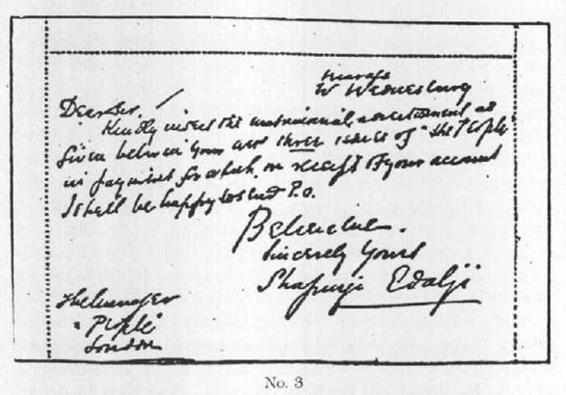
Of this man’s future I know nothing, and it may well prove, when the veil comes to be lifted, that he is simply another manifestation of the ingenuity of “God-Satan.”
I will pursue the subject in a concluding letter.
THE “MARTIN MOLTON” LETTERS — No. 3
.
We now come to the third individual whom we have constructed, the foul-mouthed boy. He is far the more interesting and important of the three, for whereas the others drop out he carries on the persecution. As I will presently show, I have myself received a letter from him within the last few weeks, one of a considerable series which have been signed by various pseudonyms, but which I will call in future the Martin Molton letters, since that was the name which was attached to the first specimen. That Martin Molton, of 1907, and the bad boy of 1892 are the same individual is, as I will show, beyond all reasonable doubt.
Let me pause here for one instant to consider the theory which I really believe still lingers at the Home Office, that the bad boy of 1892-95 was actually George Edalji reviling his own people, and writing furious letters to those who had never offended him. If the officials could only make good that proposition, when they could point to him also as being Martin Molton and all would be well. But to any unprejudiced mind, with no official theory to sustain, the thing is beyond argument. Look at the writing of 1 and also of 4. It is rude, coarse, and unformed to the last degree. Such as it is it appears unchanged in the persecuting letters up to the end of 1895. Now, at that date George Edalji was nineteen years of age, an excellent scholar”, who had finished his grammar school education, and had already started that course of legal study in Birmingham at which he was to win such distinction. Can anyone believe that he is responsible for this barbarous writing and more barbarous spelling and grammar. It is impossible to suppose such a thing, and by saying so we dispose for ever of the wild idea that Martin Molton was George Edalji, for whoever wrote the schoolboy scrawl of 1892-95 wrote the letters of 1907.
Let me now make that point clear before I go any further. I present side by side two exhibits, which I call 4 and 5. 4 is a specimen of the bad boy’s writing, dating back to 1893. Alienists will be interested in the circular dots to the i’s, which are recognised as a symptom of lunacy. 5 is a short extract from a long abusive anonymous letter which reached me on April 17 of this year, posted on that date in the N. W. or Euston quarter of London.
Compare the character of the writing. Compare the words “run” and the words “murder” in each. Compare the peculiar r’s shaped like x. Is there any reasonable man who can doubt that the thing is beyond coincidence, and that the same hand fashioned each? It may be fairly inferred, also, that the writer has been employed during the fourteen years which have elapsed in some trade which has not required much clerical work, as it is difficult to believe otherwise that he would not have developed his calligraphy.
Having, as I hope, satisfied the reader that the young rascal of 1893 is the writer of the anonymous letter quoted above, I must complete my point by showing that the latter is also Martin Molton. The handwriting of all these 1907 letters is identical, save that in some cases the Greek e is used with an ordinary r, while in others the ordinary e is used with the peculiar r. I append an extract from my letter, 6, and one from the Martin Molton series, 7, which will, I hope, satisfy the reader that they are the same script, and that they are therefore both the handiwork of the bad boy of Walsall School. T may add that of the Martin Molton series five were posted in London and two in Birmingham.
Now we have secured the two ends of our chain, and it only remains to examine those central links which are formed by the letters of 1903 — those letters which the committee, and also the jury, have most unreasonably ascribed to Edalji. I claim that I have shown these two ends to be from another hand, and if I can show that there is any correspondence or connection between them and the 1903 letters, then the latter also are from another hand. I have in my previous article shown, both by the script and by the internal evidence, that it is in the highest degree improbable that they could have been by Edalji. I now propose to show that it is, on die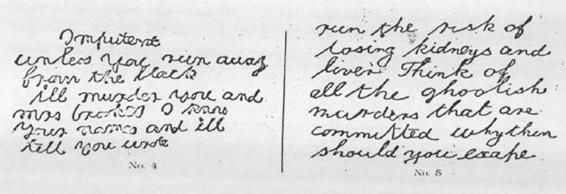
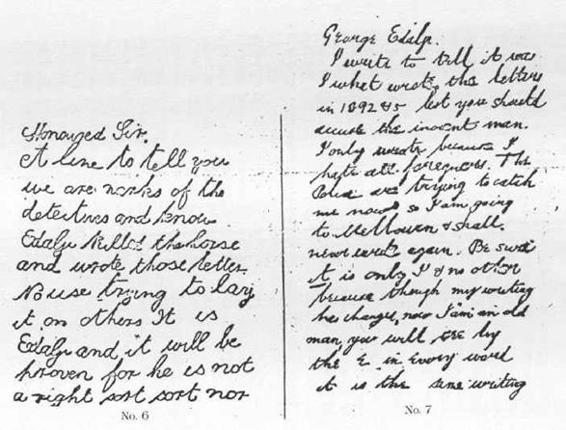
other hand, in the highest degree probable that they are by the same author as the others. Who that may be it is for those upon the spot to determine.
First of all I reproduce part of the envelope of one of the Martin Molton letters (8), and I place below it the forged signature of Wilfred Greatorex in 1903. Let the reader look at the two capital Ws. Each is curiously fashioned, and yet there is an absolute similarity between them.
Is this within the range of coincidence? I have shown that there is a history of forgery in the family from the beginning, and the actual writing is cleverly concealed, but every here and there, as in this conspicuous W, there is a glaring lapse.
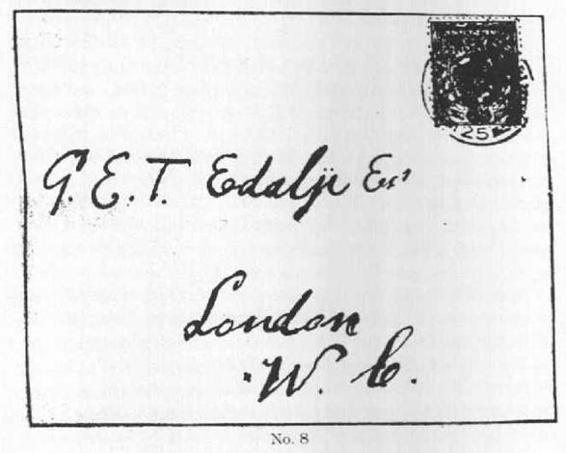
Even the same phrases recur in the different series of letters. I have one of the 1903 letters before me as I write, and I read in it, “None of the people think you a right sort,” addressed to George Edalji. Turn to exhibit 6, and you will find the same phrase applied to the same man in the letters of 1907. Is this also coincidence? See the continued ill will towards the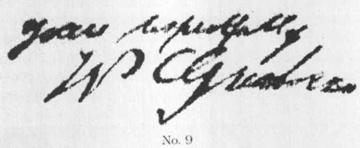
Edaljis breaking out in 1893, 1903, and again in 1907. Is this also coincidence, and is the central mystification distinct from the first and the last? It is not for me to state who actually wrote the letters of 1903, but I claim that, while in my last article I proved that all the evidence is against them having been done by George Edalji, in the present I have shown that there are very sound reasons to believe that they are from the same hand as those of 1893 and of 1907. I have also given some indications by which that hand may be traced.
Just one word at this point as to the object of all this elaborate mystification. Of that I have no doubt at all. The culprit is a lunatic, and his destination when his pranks have all been brought home to him should be, not a prison, but an asylum. The religious mania of the elder conspirator is the index of a family weakness which becomes a diabolically mischievous madness in the junior. He will be found, when exposed, to be a man of eccentric life and character, with periodical accessions of actual madness, during which he loses all prudence and control. Had the persecution been confined to the Edaljis, one might well have imagined that some secret reason could explain it, but it has broken out in so many directions, and been accompanied by such senseless deeds, that nothing but a disordered brain can be behind it Such a man is a danger to the community in which he lives, as no one can say what turn his destructive propensities may take. That he still lives in the Midlands, and possibly in the very district of the crimes, is made feasible by the postmarks of two of the Martin Molton letters. I trust that it will not be long before he is under medical supervision.
I have purposely said nothing of the outrages diem selves, and confined my remarks to the letters, since these are the only things for which Edalji is now held responsible, and it is on account of that alleged responsibility that compensation is refused him. The writing of the letters does not appear to be a criminal offence, or at worst a minor one, so that if the assertion were true that Edalji wrote diem, the country would none the less owe him compensation for his three years of gaol. I trust, however, that I have convinced every impartial man that the balance of evidence is enormously against Edalji having had anything to do with the letters. Redress for one unjust accusation has been refused by the simple process of making a second equally unjust. Nowhere in the State document is there one word of sorrow or repentance for the blunder so tardily found out. All honest, manly admission and moderate redress would have been met in a conciliatory spirit, and the matter would have ended. As it is, the sore still runs. Fortunately, behind the mutual whitewashers and the ring of interested officials, there is always the great public to whom an injured man may appeal.
Those who have followed my argument, and who agree with those conclusions, which seem to me to be inevitable, may well ask why all these documents and this reasoning have not been laid before the Committee and the Home Office. My answer is that they were so. I wish I could say with assurance that they were ever considered by the Committee. “Facts and printed matter” is their guarded description of what they have examined, and my documents could not be included in the latter. In their report there is not a word which leads me to think that my evidence was considered, and there are several passages — notably about Green, and about the eyesight — which make it difficult for me to believe that it was so. In the matter of the eyesight, the opinion of some unnamed prison doctor is endorsed, while there is no comment on the views of fifteen experts, some of them the first oculists in the country, which I sent in. As to the Home Office, I have shown them documents and demonstrated the points here set forth until I was weary. I was treated always with courtesy, but I was met also with a chilly want of sympathy. Instead of recognising that I had no possible object, save the ends of justice, and that it was their function in this country to see that justice was done, they took an obvious side in favour of impeached officialdom, and made me feel at every point that there was a hostile atmosphere around me. However, in spite of every obstacle, nine-tenths of the victory is won, and I have not a doubt that the fair-minded men of this country, apart from every consideration of persons or politics, will see that it is made complete by public apology and redress for a public wrong.
ARTHUR CONAN DOYLE
Undershaw, May 20 .